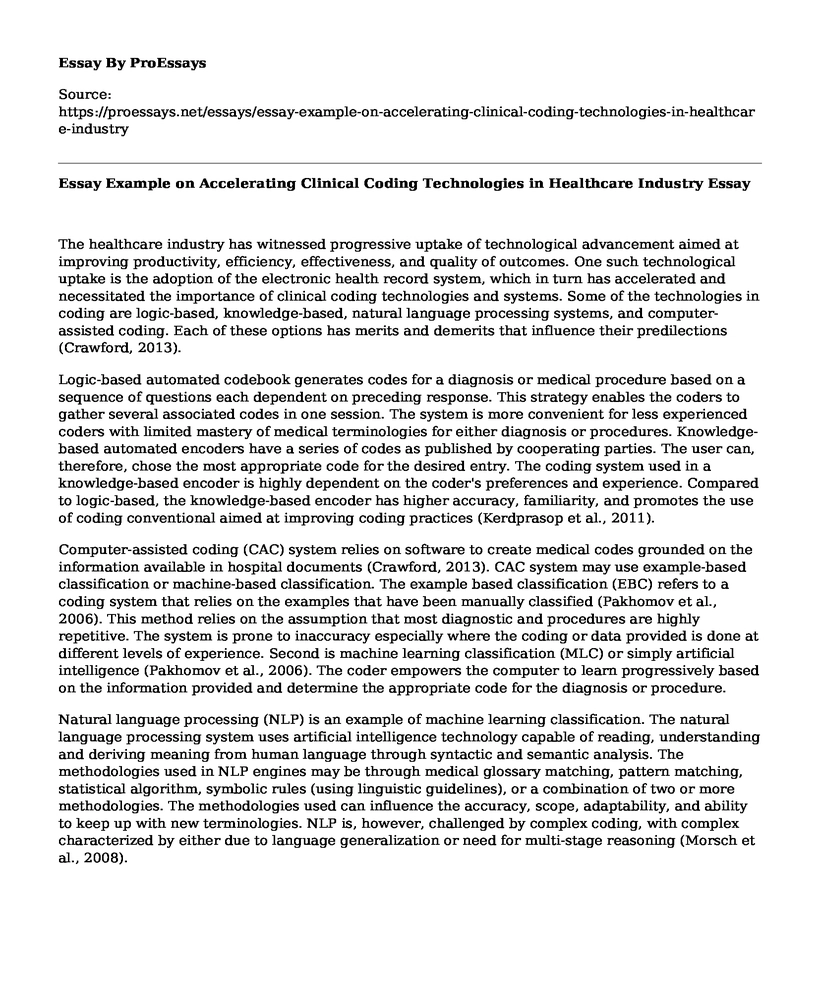The healthcare industry has witnessed progressive uptake of technological advancement aimed at improving productivity, efficiency, effectiveness, and quality of outcomes. One such technological uptake is the adoption of the electronic health record system, which in turn has accelerated and necessitated the importance of clinical coding technologies and systems. Some of the technologies in coding are logic-based, knowledge-based, natural language processing systems, and computer-assisted coding. Each of these options has merits and demerits that influence their predilections (Crawford, 2013).
Logic-based automated codebook generates codes for a diagnosis or medical procedure based on a sequence of questions each dependent on preceding response. This strategy enables the coders to gather several associated codes in one session. The system is more convenient for less experienced coders with limited mastery of medical terminologies for either diagnosis or procedures. Knowledge-based automated encoders have a series of codes as published by cooperating parties. The user can, therefore, chose the most appropriate code for the desired entry. The coding system used in a knowledge-based encoder is highly dependent on the coder's preferences and experience. Compared to logic-based, the knowledge-based encoder has higher accuracy, familiarity, and promotes the use of coding conventional aimed at improving coding practices (Kerdprasop et al., 2011).
Computer-assisted coding (CAC) system relies on software to create medical codes grounded on the information available in hospital documents (Crawford, 2013). CAC system may use example-based classification or machine-based classification. The example based classification (EBC) refers to a coding system that relies on the examples that have been manually classified (Pakhomov et al., 2006). This method relies on the assumption that most diagnostic and procedures are highly repetitive. The system is prone to inaccuracy especially where the coding or data provided is done at different levels of experience. Second is machine learning classification (MLC) or simply artificial intelligence (Pakhomov et al., 2006). The coder empowers the computer to learn progressively based on the information provided and determine the appropriate code for the diagnosis or procedure.
Natural language processing (NLP) is an example of machine learning classification. The natural language processing system uses artificial intelligence technology capable of reading, understanding and deriving meaning from human language through syntactic and semantic analysis. The methodologies used in NLP engines may be through medical glossary matching, pattern matching, statistical algorithm, symbolic rules (using linguistic guidelines), or a combination of two or more methodologies. The methodologies used can influence the accuracy, scope, adaptability, and ability to keep up with new terminologies. NLP is, however, challenged by complex coding, with complex characterized by either due to language generalization or need for multi-stage reasoning (Morsch et al., 2008).
Conclusion
In summary, all the systems have some form of limitations, but when used appropriately and with good staff training, they can improve coder productivity, coding accuracy, and consistency. The most advantageous technology is the CAC with NLP capability. Such technology can learn with the changing healthcare dynamics.
References
Crawford, M. (2013). Truth about computer-assisted coding: a consultant, HIM professional, and vendor weigh in on the real CAC impact. Journal of AHIMA 84 (7), 24-27.
Kerdprasop, N. & Kerdprasop, K. (2011).Higher-order programming to mine knowledge for a modern medical expert system. International Journal of Computer Science Issues, 8(3), 64 - 72.
Morsch, M., Stoyla, C., Landis, M., Rogers, S., Sheffer, R., Vernon, M. & Jimmink, M. (2008). Computer-assisted coding at its limits: an analysis of more complex coding scenarios. Perspectives in Health Information Management, CAC Proceedings. Retrieved 4th May, 2020 from <https://perspectives.ahima.org/computer-assisted-coding-at-its-limitsan-analysis-of-more-complex-coding-scenarios/>
Pakhomov, S. V., Buntrock, J. D., & Chute, C. G. (2006). Automating the assignment of diagnosis codes to patient encounters using example-based and machine learning techniques. Journal of the American Medical Informatics Association : JAMIA, 13(5), 516-525. https://doi.org/10.1197/jamia.M2077
Cite this page
Essay Example on Accelerating Clinical Coding Technologies in Healthcare Industry. (2023, Jul 02). Retrieved from https://proessays.net/essays/essay-example-on-accelerating-clinical-coding-technologies-in-healthcare-industry
If you are the original author of this essay and no longer wish to have it published on the ProEssays website, please click below to request its removal:
- Dangerous Consumption: Is the Consumer or the Company to Blame?
- Misuse of Opioid-Mediated Placebo in Sports - Essay Sample
- Essay on Mind-Body Duality Through Art: Reflections on Emilie O'Brien's Presentation
- Essay on Experience Genitourinary Syndrome of Menopause: Symptoms & Assessment
- Research Paper on Comparing Effectiveness of Vaccines Against Pneumococcal Infections in Elderly
- Literature Review Example on Health Care & Nursing: Protecting and Guiding Prescription Undertaking
- Paper Example on Fostering Inclusive Education: Leveraging Hopes & Abilities of Kids with Disabilities







